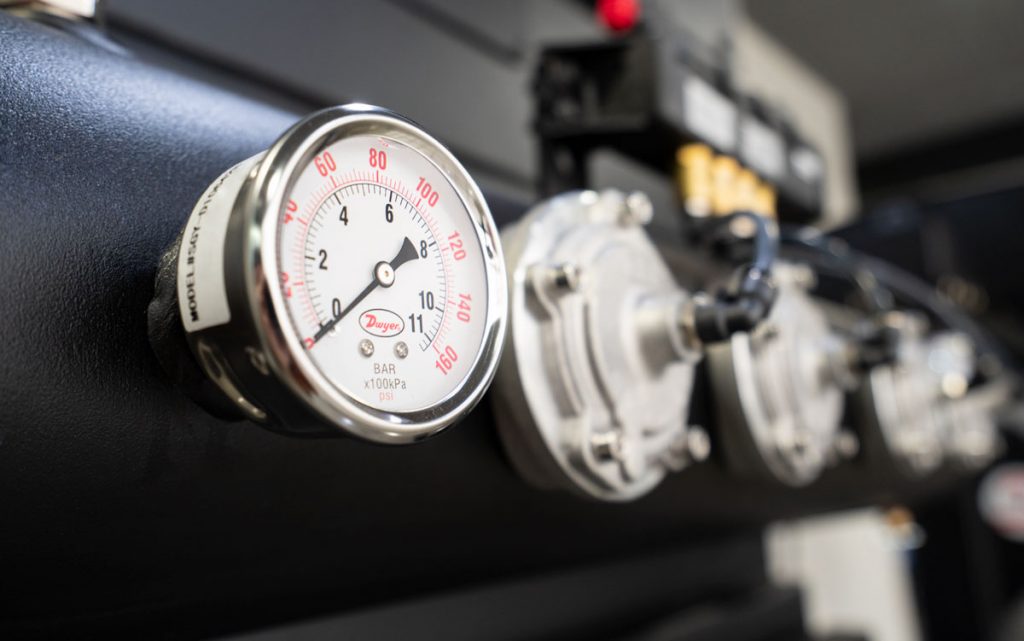Differential pressure is an integral part of understanding how a dust collector is operating. System operators and maintenance technicians can use this information to create efficient maintenance plans for equipment and the proper operation of the system. This can save you from expensive repairs, dangerous working conditions, and lost production time.
What is Differential Pressure?
Differential Pressure, also known as DP, measures the difference in pressure between the clean (clean air plenum) and dirty (filter side or dirty air plenum) sides of your dust collector. It is a measurement of the resistance to airflow between the chambers of the collector. As dust builds on the filters, it creates more resistance for the air trying to pass through.
 How Does Differential Pressure Relate to Dust Collection?
How Does Differential Pressure Relate to Dust Collection?
Differential pressure is important when it comes to dust collection because it indicates the physical changes in the filters of your dust collector. As dust builds up on the filter, it creates resistance for the air trying to pass through. The more dust and dirtier the filter, the more unequal pressure is created, which will result in a higher DP reading.
One way to think about this concept is when you are drinking from a straw. If you drink water through a regular straw, you will be able to drink the water without much effort. However, if you were to pinch the straw, it will take much more effort to drink the same amount of water as before. This is because there is much less volume flowing through the straw compared to when it is unobstructed.
This is the same thing that is happening in your dust collector. As the filter in your system becomes dirty, the differential pressure rises because the holes for airflow become smaller. As DP rises, adjustments must be made to compensate for the loss of suction. If the unit features a VFD (variable frequency drive), it will automatically adjust. If not, manual adjustments must be made with a slide gate or fan damper to adjust airflow.
Why Is It Important For Dust Collection?
Now that you understand how differential pressure relates to dust collection, let’s discuss why it is important:
The differential pressure is important for dust collection because it indicates what is happening physically to the filters of your operating system. The main use of the readings is to determine what the health of the filters are inside the unit. Differential pressure begins to rise when the filters in the unit are creating resistance. A DP staying above 5” of water gauge means that it is time for the filters to be replaced. This also means a DP around 4.5” W.G. is a good time to order replacement dust collector filters.
These readings will also help you troubleshoot and prepare a maintenance plan to ensure the safest working conditions and environment within your operations. By tracking the small performance changes within your dust collecting system, you can diagnose and respond to any issues swiftly. This will also require little to no downtime in your operation.
Do Not Neglect The Readings
The readings of differential pressure are often used to determine whether the dust collector is running at the required efficiency. There may be specific parameters for air quality permits in your area that are set by local, state, or federal agencies. The differential pressure readings may be requested to ensure compliance with the local ordinances for permits. Operations that are not within compliance are subject to heavy fines.
In one instance, a company was fined for operating one of its dust collectors with a broken pressure gauge and without accurately reporting their differential pressure readings. This specific company was fined $325,000. The fine also does not account for lost production time or repair costs. The key takeaway is to take your readings and the health of your dust collector very seriously.
How Can You Use Differential Pressure to Control Filter Cleaning?
Using the differential pressure readings to control automated filter cleaning has many benefits including: compressed air savings opportunities, lower total emissions, longer life on solenoids and diaphragms valves, and potentially longer filter life.
The CMAXX Dust and Fume Collection System offers maximum cleaning performance with 10% more filter media than competitors’ models. The CMAXX features powerful pulse cleaning technology to increase filter life and efficiency. Its heavy-duty design makes the CMAXX the most durable dust and fume collector in the industry, it offers the patented weather-resistant CrownTech roof and no external bolt holes. In addition, the modular design of the CMAXX means it can be customized for each application.
Conclusion
Differential pressure can make or break the health of your dust collector. Without monitoring the differential pressure and health of your filters within your dust collector, your operations are subject to fines, costly maintenance, and dangerous working environments. But when you track and observe your differential pressure levels, you can quickly respond to fluctuations in your system. This will allow you to create thoughtful maintenance schedules, understand the inside health of your collector more than ever, and make more sound operational decisions within your business.


